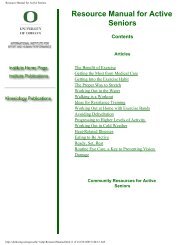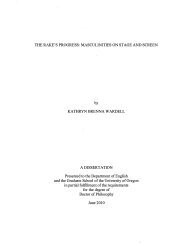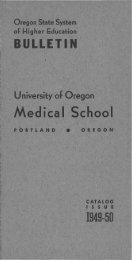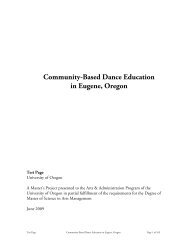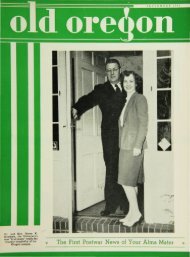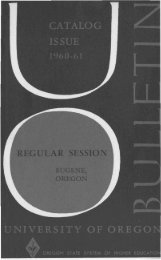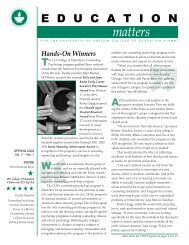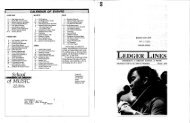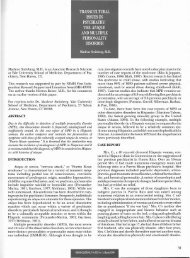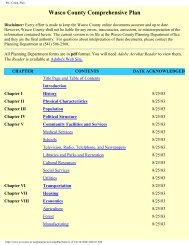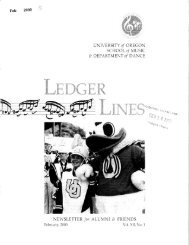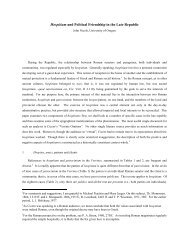~EGULAR SESSION - University of Oregon
~EGULAR SESSION - University of Oregon
~EGULAR SESSION - University of Oregon
Create successful ePaper yourself
Turn your PDF publications into a flip-book with our unique Google optimized e-Paper software.
ENTRANCE EXAMINATIONS 67<br />
Credit transferred from an accredited junior college may be counted only as a<br />
part <strong>of</strong> the first 93 term hours earned toward a baccalaureate degree.<br />
No advanced standing is granted at entrance for work done in nonaccredited<br />
collegiate institutions. However, after three terms <strong>of</strong> satisfactory work in the <strong>University</strong>,<br />
an undergraduate student transferring from a nonaccredited institution<br />
may, on petition, receive credit in <strong>University</strong> <strong>of</strong> <strong>Oregon</strong> courses to which courses<br />
taken at the unaccredited institution are approximately equivalent; validating examinations<br />
may be required. Petitions for such credit may be based only on regularly<br />
organized college-level courses.<br />
Transfer students are required to file with the Office <strong>of</strong> Admissions: (1) complete<br />
<strong>of</strong>ficial records <strong>of</strong> all school work beyond the eighth grade; and (2) a certified<br />
score on the College Entrance Examination Board Scholastic Aptitude Test.<br />
College records must be certified by the registrar <strong>of</strong> the institution providing the<br />
record; if the student's high-school record is adequately shown on his college<br />
transcript, he need not obtain another record direct from his high school. If a<br />
student has taken the Scholastic Aptitude Test on a previous occasion, he need<br />
not take it again, but may obtain and submit a transcript <strong>of</strong> his score from the<br />
College Entrance Examination Board.<br />
Admission to Major Programs. Several <strong>University</strong> schools and departments<br />
have special requirements fOJ' the admission <strong>of</strong> transfer students as majors and<br />
for the granting <strong>of</strong> transfer maj or credit-in addition to the general requirements<br />
<strong>of</strong> the <strong>University</strong>. These requirements are frequently set in accordance<br />
with the standards <strong>of</strong> national pr<strong>of</strong>essional accrediting organizations. Where there<br />
are such special requirements, they are stated in school and department sections in<br />
this Catalog.<br />
Admission <strong>of</strong> Special Students<br />
Students qualified by maturity and ability to do satisfactory <strong>University</strong> work.<br />
but who fail in some respect to meet the requirements for regular standing, may<br />
apply for admission as special students. Requirements for special-student admission<br />
include a satisfactory score in the College Entrance Examination Board<br />
Scholastic Aptitude Test and the joint approval <strong>of</strong> the Director <strong>of</strong> Admissions and<br />
the dean <strong>of</strong> the college or school in which the applicant wishes to study. Specialstudent<br />
status is not granted to upper-division students with less than a 2.00 GPA.<br />
A special student should qualify for regular standing as soon as possible, by<br />
satisfactory <strong>University</strong> work and by the removal <strong>of</strong> any entrance deficiencies; if<br />
his grades when admitted were below a C average, he must raise his cumulative<br />
average to that level before being granted regular standing. A student may not<br />
continue for more than 45 term hours <strong>of</strong> <strong>University</strong> work under special-student<br />
classification without explicit permission (which is seldom granted). A special<br />
student may earn credits toward a degree; to qualify for a degree, however, he<br />
must complete at least 45 term hours <strong>of</strong> work after he has been granted regular<br />
standing. (In case a regular student changes to special status, work done while a<br />
special student will not apply toward a degree.)<br />
Admission to Graduate Standing<br />
For requirements and procedures for admission to graduate study see GRADU<br />
ATE SCHOOL, pages 105 ff.<br />
Entrance Examinations<br />
TO PROVIDE THE FACULTY with a basis for reliable advice and assistance<br />
to students in planning their programs and, in certain cases, for determi-



